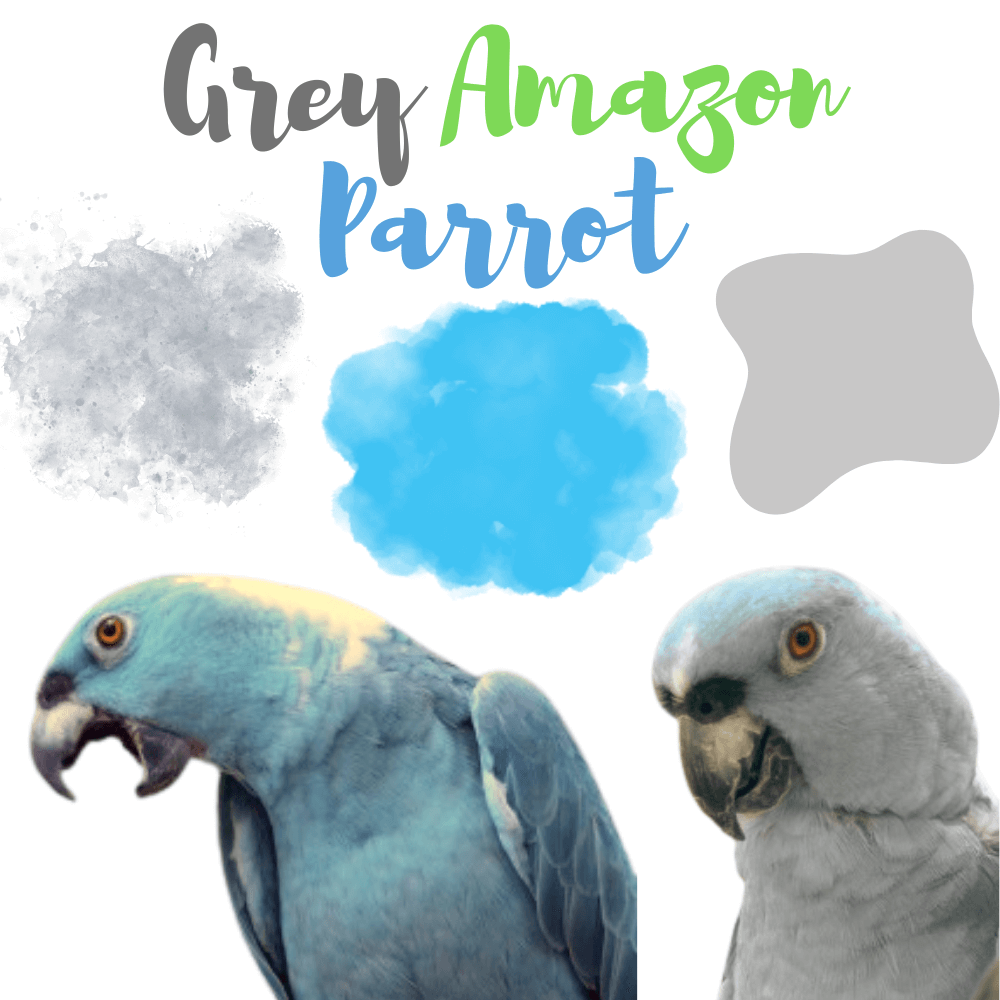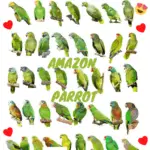
The Amazon parrot adapts more easily than the African grey parrot because they are less anxious and less stressed.
But it’s totally different from the African grey parrot.
- Is the Amazon less possessive than the Grey?
- Does grey speak better?
- Amazon is less “stressed?
The African grey is observant, we can have a little discussion with them, and they adapt the words to the situations.
They form completely understandable sentences, they test, stare, answer, and swear…
Those who do not speak, know how to make themselves understood very well.
An Amazon parrot is playful, impulsive, cheeky, jealous, and resentful, she sets a course of action and sticks to it, too bad if it’s not to your liking.
The African grey is also jealous and resentful, but he does not express it in the same way.
He will mutilate himself more easily than run into the darling.
The Amazon parrot will go straight to the point by attacking the enemy target, she is often wrong, but her impulsiveness is stronger than anything.
Question of speech, the amazon speaks, but does not respond to sentences, not that she is less gifted, but does not find the need to hold a dialogue.
Both are very endearing, but the love he gives doesn’t feel the same.
Some people are better in the presence of amazons, while others can’t stand the look of an African grey parrot.
Amazon Parrot is more expressive than Congo African grey when angry.
They emit “grunts” or guttural cries, the feathers of the headstand up, and immediately they attack.
When attacking from the front, you can always dodge, but from behind, it’s already less easy.
The gray attacks more willingly from behind, especially the back of the neck.
But hey, you need a cause, it’s often the hormones that make them act.
All African grey parrots are different, and for amazons parrot, it’s even worse, because not all species are alike, even if they have things in common.
As a general rule, the Amazon parrot is easier to decode than a Congo African grey, because the gestures of the Amazon are franker than those of a grey parrot.
Not that gray is sneaky, but he has several gestures that look the same, but in a different situation, they mean something else.
It’s very rewarding, but also very frustrating and dangerous when you don’t get it in time.
Amazon parrot vs African grey

What parrots can you keep at home?
Intelligent, sociable, and endowed with beautiful plumage, parrots are birds that many people want to have in their homes.
Despite everything, the acquisition of a parrot must be considered, because it does not require the same care as more “classic” birds such as parakeets or canaries, they require much more attention and maintenance.
The African Grey
The Congo African grey or African grey parrot ( Psittacus erithacus ) is a parrot in the Psittacidae family. This parrot, known for its uniform grey plumage and red tail, is native to central and western Africa.
In the wild, it lives in the forests of these regions, with its cousin the Timneh Grey, in large groups of several hundred individuals.
The Congo African grey is frugivorous and granivorous, it feeds on seeds that it finds in human plantations, and on fruits present in the forests that it inhabits.
On average, it measures between 35 and 42cm, weighs about 410g, and generally lives 30 years in the wild, although there are individuals, especially in captivity, which, well cared for, can live up to 80 years.
In captivity, the grey parrot is the most sold parrot in France. This bird fascinates me because it has an extraordinary capacity for learning.
However, you will have to take the time to educate him every day and spend a lot of time with him. Being a sociable animal, the parrot African grey does not tolerate loneliness for too long periods.
To teach him to speak, nothing better than repeating words to him over and over, until he remembers them and repeats them.
Given its great popularity, regulations have been put in place in France regarding the acquisition of a Congo African grey. Today, it is in annex 1 of the Convention on International Trade in Endangered Species of Wild Fauna and Flora (CITES), which means that its trade has become prohibited
Amazon Gray parrot
The blue-fronted parrot ( Amazona aestiva ) belongs, like the Gabon grey, to the family Psittacidae. It is certainly the second most famous parrot, especially for its magnificent plumage, green, scaled with yellow on the ventral parts, sometimes the shoulders, and around the eyes. Finally, his forehead is colored a pale blue, hence his name.
The blue-fronted Amazon is native to South America, where it inhabits tropical forests from Brazil to Paraguay and from Bolivia to Argentina. It feeds on seeds, berries, and fruits that grow in its natural environment.
It measures on average between 35 and 40cm, weighs around 450g, and has a lifespan in the wild of around 40 years, but just like the Gabon grey, it can live up to 80 years if it is well cared for. captivity.
In captivity, the blue-fronted amazon is not to be put in all hands. Although he can be very sociable, playful, and endearing, he can also be very destructive and loud.
It is therefore not a bird that is very suitable for living in an apartment (neighbors may be bothered by its noises). He will therefore need a master or mistress capable of managing his changing moods.
The blue-fronted Amazon is also able to speak. Even if this faculty is less developed than in the Gabon grey, it is possible to teach it a few words, at least in some individuals, because others are simply not capable of it.
The blue-fronted parrot is a very curious bird, and its way of expressing it is to nibble at anything that interests it. So remember to give him all kinds of toys to abuse in his crate, and be very careful if you let him out, because he could be attracted by an electrical wire.
The last point, is the blue-fronted amazon tends to be overweight, so pay attention to the amount of food you give it as well as the fat content in it.
The animal is protected by Appendix II of CITES or the Washington Treaty.
There are 31 kinds of Amazon Parrot:
- Double yellow-headed Amazon
- Blue-fronted Amazon
- Yellow-naped Amazon
- Lilac-crowned Amazon
- Orange-winged Amazon
- White-fronted Amazon
- Mealy Amazon
Grey amazon parrot

Mutations: the myth of the blue-bird and yellow-naped Amazon (Amazona auropalliata)
By dint of research, two pairs of wild subjects finally gave birth to natural blue and grey mutations. Each year, these parrots occupied the same nest during the breeding season. But broods producing subjects of this hue rarely appeared.
A breeder named Voren was lucky enough to be in Honduras just at the right time, to retrieve two young blue and grey-mutated Amazons from separate nests. The height of luck was that it was a couple. They were the one and only pair of Blue Amazons in the world. After countless expeditions, only two other specimens were held in captivity, but at maturity, they were identified as males. Their pairing with females of standard color was then attempted in desperation, but it was unsuccessful.
The couple formed by Voren finally produced the long-awaited offspring, the first blue and grey mutations of yellow-naped Amazons (Amazona auropalliata) born in captivity finally saw the light of day. Three other pairs were thus gradually placed in the three best farms in the world.
A few years later, Voren was contacted by the person who had provided him with his first two birds. A second pair from the same nest as his male was available for sale. So they were brothers and sisters. But the export of parrots was now banned in Honduras, which required their transfer to Nicaragua and then to the United States. Voren declined the offer.
A less scrupulous American importer of reptiles acquired them, before offering them to him, but Voren refused a second time. The couple ended up on a Californian farm, where they gave birth to inbred subjects intended for sale or public presentation, which exposed them to various risks of contagion.
Nowadays, the blue and Grey mutations of yellow-naped Amazons are still marketed at high prices. Given the potential fragility of subjects from the Californian strain and the cost of such an animal, it is therefore more than ever advisable to resort to serious breeding. If you want to adopt this fabulous parrot, still consider making some savings beforehand, because it will cost you between 16,000 and 19,000$. In Kuwait, a specimen was even purchased for the price of 232,000$. The legend is very expensive.




















